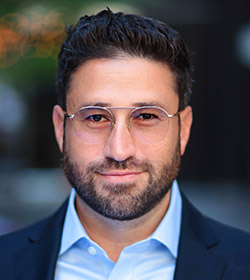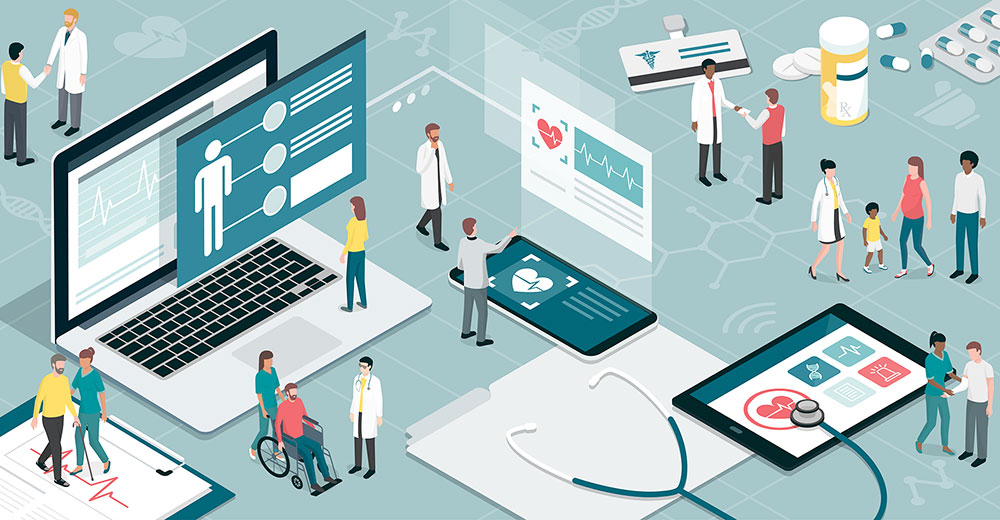Health care, at its core, is a business operation that delivers health and wellness solutions. But its differences should not exclude the type of health tech advances experienced elsewhere, according to Josh Builder, chief technology officer of Signify Health.
Some critics note that nonprofit providers dominate large segments of the health care industry. They also point out that third parties like the government and private insurers typically make the payments, highlighting these factors as limitations in the industry’s integration of tech solutions.
According to the National Institutes of Health (NIH), the U.S. medical research agency, one of the most widespread uses of technology in the health field is the adoption of electronic health records (EHR). The process makes patient health information instantly accessible to providers and patients by supporting automated workflows between people and technologies.
Still, Builder noted that health care technology could learn a few improvement remedies from other tech trades.
Before moving to his current role, he was an executive at Rent the Runway, the premier subscription fashion service for designer clothes; SoulCycle, the indoor cycling, and spinning workout class company; and The Orchard, an early pioneer in music streaming.
His background in fitness, fashion, and music established his expertise in solving complex problems through technology. Builder now applies this tech knowledge to practice a unique approach to health care.
He contends that businesses in today’s world need to understand that technology should not be an afterthought or add-on capability. Rather, it should be woven into the fabric of the organization and its business operations.
Stretching the Fabric
On March 29, CVS Health announced the acquisition of technology and services company Signify Health to close gaps in patient care, bring caregivers into patients’ homes, and address social determinants of health. Signify has a network of more than 10,000 clinicians in all 50 states.
“This transaction advances our value-based care strategy by enhancing our presence in the home,” said CVS Health President and CEO Karen S. Lynch. “Our expanded capabilities will bring us closer to the consumer as we continue to redefine how people access and experience care that is more affordable, convenient, and connected.”
According to the CVS statement, the combined company will work to improve care delivery capabilities, lower costs, improve levels of engagement, and enable broad access to high-quality care, especially for Medicare Advantage customers.
Under the terms of the transaction, CVS Health is exchanging each outstanding share of Signify Health common stock for $30.50 in cash, representing a total transaction value of approximately $8 billion. CVS Health funded the transaction price with existing cash and available resources and is committed to maintaining its current credit ratings.
Health Care Technology Discussion
We engaged Builder in a conversation about the role technology can play in dispensing health care better as the two organizations join forces.
TechNewsWorld: What insight does your technology experience in other spaces tell you about how these concepts can provide a unique approach to health care?
Josh Builder: This question is so interesting to me because I do not think of my career as a sequence of “technology experiences.” But I suppose there is some truth to that. I have been CTO at numerous companies, spanning different industries. On the surface, they have absolutely nothing in common. But working in these varied industries taught me to look beyond the surface differences to see what I would call “patterns.”
In short, all these companies may have had different technical approaches, but they shared common challenges, and I was CTO at these companies at the very moment when technology was causing these huge shifts in the way they had to think about their work and even how they crafted their business models.
How has that influenced what you do at Signify Health?

Josh Builder, CTO
Signify Health
Builder: I have been able to take a step back and begin to pull out these common technical themes to apply to the health care space, and it is exciting to be part of another one of those seismic shift moments.
I recently found myself talking about security and compliance and how it is pretty impossible to successfully shoehorn that in at the later stages of a business. I think that is probably true of most things.
The later the tech organization is brought in, the more challenging it will be to develop truly innovative technology solutions and integrate them elegantly and effectively. Part of the challenge, frankly, is that health care is an older industry with a well-worn model of doing the same things over and over, such as optimizing claims processing.
That worked for decades; the tech was just this costly and clunky facilitator. But things are changing in health care, so businesses need to think of technology as a strategic engine integral to an entirely new health care ecosystem.
How do you connect the dots that let the health care industry better use technology?
Builder: Much of my job is storytelling at a very high level. I will dig into a metaphor here if you just bear with me. Before the advent of digital music, stores sold LPs, CDs, and cassettes. I, for one, still have way too many LPs. But selling these physical assets was a pretty easy business model to understand.
Now, if you think of a company like Spotify, the music industry is much more complex and rooted in getting customers to engage. In short, how you can make money in that industry has changed wildly.
So, maybe health care is a bit like that music store from the 90s. It once had a pretty clear model and ecosystem. But now things are different, and we are engaging people in a whole new host of ways.
How can health care, in particular, be better integrated to improve the health care customer experience?
Builder: I think one of the defining characteristics of the health care system now is that it is extremely complex. Frankly, it can be very confusing and frustrating to navigate.
For example, something that should be routine, like trying to understand payments or staying in touch with your provider, can become a behemoth task because we do not have the appropriate technology to empower consumers or put them first.
We just need to make things easier. Part of that is about simplification, and the other piece is about providing more options for care. Unfortunately, the way our current system works is just not designed with the consumer in mind.
Think about logging into your health care portal and having no clue where to look or how to confirm your coverage or cost. Not to mention, you might not even trust if the information is up to date. And there is no “best brand” when it comes to this, either.
So, the opportunity for Signify and CVS is to create the first truly consumer-friendly offer. Simple, more options, and all with the consumer’s care and time in mind. That is really impactful.
Given your current role as chief technology officer of Signify Health, what do you see as the biggest hurdles to integrating technology better?
Builder: If you had asked me at the beginning of my career if I would be CTO of a health care company, I probably would not have believed it. Good technologists like me have not really inhabited this space before now.
But we are starting to gravitate toward health care more and more because we are realizing just how complex and interesting the problems are to solve. It can be deeply gratifying to work on something challenging and unprecedented. To my point earlier, there is an opportunity for technology here to have an impact.
We all engage with the health care system as civilians, and I think we can all agree that it is not consumer friendly. So, we have a vested interest in improving it. Our work is genuinely mission-driven, and that can be really personally motivating when you show up every day.
One of the exciting things about the CVS acquisition is all the other products we are bringing into people’s homes on top of what we already do. It is exciting to look at the possibilities.
What role should AI play in improving health care operations?
Builder: The potential for AI in health care will ultimately touch all aspects. Maybe not for a while, but I think it will eventually. The health care industry is particularly excited about generative AI but also unsure what the right place is.
However, right now, as we explore its capabilities, the best place for AI is streamlining and making decisions on routine health care processes rather than operating in direct contact with a patient.
There is much to consider. Empathy, protected health information under the HIPAA Privacy Rule, and how we protect our members and patients are critical. But I cannot deny that there is an excellent opportunity to use AI to automate more manual tasks, such as data entry.
If you do a quick search on the subject, you will see a lot of noise around articles that claim things like “AI is better at talking to patients than doctors.” But we are a long way from that being the case.
Of course, talking to a person still has value, and there is no incentive to pretend that is not true all of a sudden. The most significant advancements in health care due to AI will probably be around esoteric knowledge sets that people have in their heads.
If anything, it will automate processes to the point that providers can engage with their patients on a deeper level and increase a human connection that makes folks feel valued.
Enhancing Health Care’s Future With Tech and Talent
Builder noted that much of Signify Health and CVS’s efforts are focused on the new R&D center in Galway, Ireland, and he is heavily focused on recruiting top-tier talent.
Tech start-ups have a certain shine and appeal for engineers. The work itself can be complex and interesting, but there is no substance behind it. For instance, it has no larger picture or mission that means anything. Yet that industry does a much better job than we do at articulating the complex technology problem that needs to be solved that attracts top-tier talent, he observed.
“The health care industry needs to articulate better the tasty challenges we solve daily and turn the volume up on the technical aspect of what makes the work here so stimulating, innovative, and rewarding,” said Builder.
“This new process of creating technology is at a turning point in American health care and is having a huge impact on people’s lives. We need to better sell the work, alongside the mission. Most industries do not have both. We do,” he concluded.























































